Intel’s elusive Arc platform has been in the pipeline for many years, and for most of that time, it has largely been shrouded in mystery. But with the official release of the new Intel Alchemist GPUs right around the corner, the time for Intel’s official return into the dedicated GPU space is finally here. This is the first dedicated GPU platform Intel has made since the late 1990s — when they launched their first and only GPU, the i740 AGP graphics card. With the release of the Intel Arc A380 (released in June), the first impressions of the Arc lineup haven’t been anything to write home about, but the excitement for Intel’s GPUs remains. This is a testament to the fact that industry watchers are excited about the fact that Intel’s entry into the space might finally end the decade-long duopoly of Nvidia and AMD. So what is Intel’s Arc platform? And can it compete with Nvidia or AMD Radeon GPUs? Let’s find out.
Intel ARC Graphics: Explained (2022)
Hype aside, what we want to do through this article is objectively explore the various aspects of the Arc lineup, from its architecture and specifications to its performance and flagship features. The Arc GPUs are touted to be the next step in graphics architecture, and for that alone, they deserve a technical deep-dive. Also, we want to see how Intel Arc graphics compare to Nvidia or AMD Radeon GPUs.
Now analyzing these aspects of the Arc graphics lineup is going to be a little tough, as a lot of information is still uncertain (Intel has been quite reserved about the details), however, the last few months have been kind to us. We have had a variety of leaks from various sources, which have told us a great deal about the new GPUs. Moreover, with the sprinkling of important details about the architecture from Intel, we might finally have enough information to make certain assumptions as to what we can expect from Arc CPUs in terms of performance and features. Now if you want answers to any specific questions, navigate to them using the table given below.
Why Did Intel Develop the Arc GPU Platform?
The first reaction we had when Intel showcased its dedicated GPU all the way back in 2020 was a sense of bewilderment. Like us, most PC enthusiasts wondered why Intel, a leader in the CPU market at the time, would take this radical jump into the discrete GPU space.
Now, as then, there is no exact answer to why Intel decided to enter the dedicated graphics space. But if one looks at it with hindsight – the company’s aspirations were clear back in early 2018 when they decided to hire Raja Koduri from AMD, followed by chip architect Jim Keller and graphics marketer Chris hook. Raja was one of the key minds behind AMD’s graphical renaissance of the mid-2010s and helped them construct the Vega and Navi architectures. If one read behind the lines, it was clear that Intel was vying for a space in the high-end graphics market.
If one were to speculate why Intel did this, we could just look to simple economics. Intel, like all capitalist enterprises, is constantly looking to expand, both in terms of size and profits, and what could be a better opportunity than the ever-growing dedicated GPU space? The GPU market size was expected to grow 94% from $18.2 billion in 2018 to $35.3 billion by 2025, and one could argue that Intel wanted a piece of that pie.
Furthermore, we could also conclude that since Intel was already in the GPU market through its iGPU lineup, the only way they could have a bigger piece of the GPU market was through manufacturing high-performance graphics (HPG). The PC gaming market was and still is a huge opportunity for Intel, and Intel was cognizant of that.
Another reason for Intel’s foray into this market could be that while Intel calls itself a leader in a “broad range of computer segments”, its impact on markets that are not CPU based is relatively low. This is the reason why Intel has been trying to diversify by going into a range of other hardware products like storage, RAM, and now dedicated graphics.
Just like “Optane” before it, Arc GPUs seem like a clear case of diversification. And to answer why? We believe that this sudden drive for diversification could be a result of what’s happening on the other side of the industry. Intel is facing an existential threat in the CPU world in the form of AMD’s Ryzen 7000-series processors. Year after year, their once dominant market share has been waning. The writing is on the wall – adapt or perish. And Intel Arc might just be the Deus-ex machina that Intel needs.
A Look at Intel Arc Alchemist Architecture
Coming to the current state of things, after years of hard work, Intel has finally released its first set of graphics cards under the Intel Arc lineup (codename Alchemist). Now it would not be wrong to say that Intel is a newcomer to the graphics market, as the new Arc GPU series is the company’s first foray into the segment in decades. But we have to keep in mind that while they are new to dedicated graphics, they are by no means new to making GPUs.
Intel has a storied history in this industry and has been at the forefront of graphics technology many times in the past. Most recently, they released the Xe graphics architecture with their Tiger-lake CPUs, which brought a huge upgrade from the older UHD graphics. And the Xe graphics performance was so impressive that it pushed Intel to the same level as AMD when it came to integrated graphics.
The Arc architecture, in a sense, is an improvement upon the Xe graphics – changing many bits of it, but at the same time, keeping some core elements intact. The changes, though, are large enough that Intel has ditched the Execution Unit naming of the previous architecture and has named their new graphics block – Xe-core.
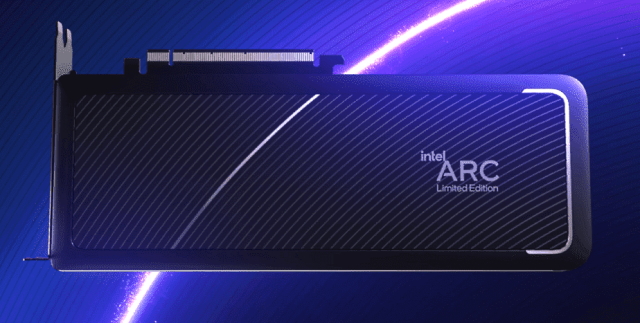
What Is a Xe Core in Intel Arc GPU?
To start, a Xe-core contains 16 Vector Engines (formerly known as Execution units), each of which operates on a 256-bit SMD chunk. Each vector unit, in this case, can process eight FP32 instructions simultaneously, each of which is traditionally called a “GPU core” in AMD and Nvidia architectures.

Then, Intel takes this Xe-core and forms a larger unit called a Render slice. This slice contains four Xe-cores, 64 Vector and Matrix Engines, plus additional hardware. We can see what the architecture looks like in the image above. It’s complicated-looking, for sure, but it’s also an advanced chip that contains many different tools, making for a truly cutting-edge architecture.
Xe-cores, however, represent only a part of the feature set that accompanies the new Arc graphics architecture. The Arc architecture is a complex system that includes other rendering units like four ray tracing units (one per Xe-core), geometry and rasterization pipelines, Texture Mapping Units, and the pixel backend (ROPs).
A particular feature that we are excited about is the new ray tracing unit (RTU) of the Xe-cores. The fact that Intel is going to include this cutting-edge feature in its first attempt – a feat that not even AMD could achieve – is commendable. For now, Intel has claimed that its RTU can do up to 12 rays per box, which is a bit higher than both Intel’s RT cores and AMD RDNA 2 Ray Accelerator. Theoretically, that means that a single RTU core should pack more ray tracing power than a single RDNA or RT core. But the fact that we don’t have any hard evidence means that we should take this claim with a pinch of salt.
Another thing we have to keep in mind is that even though Intel Xe’s RTU might be more powerful than AMD or Nvidia’s solution on paper, it still lacks in overall power, as the maximum number of RTUs that ship with Intel’s highest-end card (Arc A770) is only 32, while AMD has up to 80 Ray Accelerators in the RX 6900X and Nvidia has 84 RT cores in the GeForce RTX 3090.
Intel Arc GPU Models and Specifications
So now that we have looked into the details of the Intel Alchemist architecture, let us start with a general overview of the entire GPU lineup. Until now, Intel has said that their Arc lineup will cover two different GPU dies (different underlying chip architecture) that will be further divided into three different product families – Arc 700 series, 500 series, and 300 series. And as expected, they will be divided on the basis of price and performance. Let’s look at how these cards are differentiated below:
Specifications Arc A770 Arc A750 Arc A580 Arc A380 Architecture ACM-G10 ACM-G10 ACM-G10 ACM-G11 Process Technology TSMC N6 (6nm) TSMC N6 (6nm) TSMC N6 (6nm) TSMC N6 (6nm) Transistors 21.7 billion 21.7 billion 21.7 billion 7.2 billion Xe-cores 32 28 24 8 Clock speeds 2100MHz 2050MHz 1700MHz 2000MHz VRAM (GDDR6) 16/8 8 8 6 XMX Engine units 512 448 384 128 VRAM bus-width 256 256 256 96 GPU bandwidth (Gbps) 560 512 512 186 TDP (in watts) 225W 225W 175W 75W Release Date (rumored) Oct 2022 Oct 2022 Oct 2022 June 2022
The only Intel discrete GPU that has seen an official specs announcement or has been covered by other publications is the entry-level Arc A380, which is also the only one that has had any kind of launch around the world (available in China). In terms of specifications, it’s the weakest one that has been revealed to us till now (officially), with only eight Xe-cores and ray tracing units. However, it does come with a decent memory size of 6 GB, which is more than other entry-level GPUs (Radeon RX 6400 has only 4 GB of VRAM)
The other GPUs that we know about are the Intel Arc A580, A750, and A770. They are supposed to be mid-range GPUs, comparable to other mainstream GPUs from Intel and AMD like the 6600X and the RTX 3060. These GPUs are largely similar in structure to each other, as they all share a 256-bit memory bus and 8GB of GDDR6 RAM. But what they differ in is the number of Xe-cores. The A580 comes with 24 Xe-cores, the A750 with 28 Xe-cores, and the A770 with 32 Xe-cores.
The Arc GPU model that Intel has showcased the most till now is the A750 limited edition, as it has been used in most of the performance showcase videos. The “limited edition” moniker here doesn’t entail any performance change, as it mostly shares the same components as the non-limited cards. The basic board and fan design and 225W power remain the same, but it does have a first-party cooler setup, much like Nvidia’s Founder edition cards. Also, in the case of the Intel Arc A770, you get built-in LEDs for that added gamer look.
There have been some speculations of a fifth low-power Alchemist GPU, the Arc A310, which has been spotted on manufacturer’s websites but hasn’t been officially announced by Intel. For example, in a recent article on Appauls, we saw the mention of a pre-built MSI DP130 PC with the Arc A310 GPU on the specs page. It has since then disappeared and is also absent from Intel’s own Arc website. So we don’t really know what its current predicament is. It may have been delayed or canceled completely.

Intel Arc Alchemist GPU: New Features
Ray Tracing Support
The premier feature that everyone is excited about, as we previously mentioned, is the ray-tracing capability of the new Intel Arc GPUs. As Intel has told us many times, the Arc graphics cards have been constructed from the bottom-up around the DirectX 12 feature set, and ray-tracing was a feature they had thought about since the beginning. But the list of new features doesn’t end here, as the Intel Arc GPUs also come with support for other important DirectX features like variable-rate shading, mesh shader, and sampler feedback. Let’s look at other new Arc GPU features:
Xe Super Sampling: Intel’s Take on DLSS and FSR
Since we have already talked about Arc’s ray-tracing cores in our earlier section, let’s move to the next most talked about feature of Intel’s Arc graphics – XeSS.
The AI upscaling feature called XeSS (Xe Super Sampling) is powered by their new XMX engines. This feature works similarly to Nvidia DLSS, AMD FSR 2.0, and FSR 2.1, in the sense that it uses AI technology to upscale games rendered at lower-than-native resolution.
The process is quite complicated, but to put it simply, XeSS uses information from spatial and temporal data, i.e. both image data and motion data from previous frames, and leverages AI to further improve image quality.
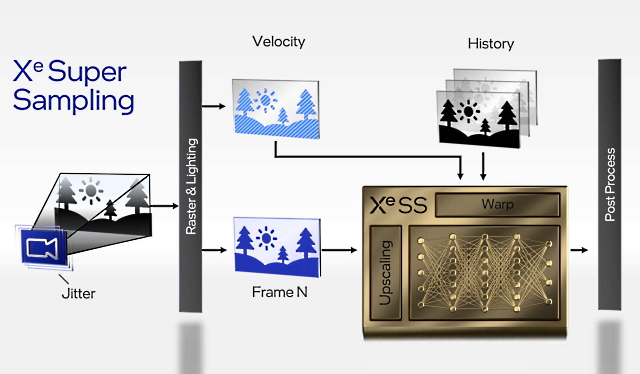
If you wish to read about how XeSS works in more detail, you can check out the recent blog post shared by Intel. One important detail that Intel has emphasized is that XeSS doesn’t just act as an upscale model but also as an anti-aliasing solution like Nvidia’s DLSS. This means that on top of upscaling the game’s resolution, the GPU also removes sharp edges from pixels by using a smoothing technique.

Furthermore, just like DLSS and FSR, XeSS does not run natively in a video game and requires the developers to actively implement support for it. That means not all games will support this upscaling technique at the moment. This is indicated in the number of games that actively support this technology, as revealed by Intel. So far there are only 14 games listed on Intel’s website. But like all the other AI-based upscaling (DLSS and FSR) techniques, the support for the technology is limited at launch but will most likely grow in the future.
Currently, the games that support XeSS on Intel Arc graphics are listed below:
- Shadow of the Tomb Raider
- GRID Legends
- Ghostwire: Tokyo
- Death Stranding
- Vampire: The Masquerade – Bloodhunt
- Chorus
- Enlisted
- Chivalry II
- Dolmen
- Arcadegeddon
- The Settlers
- Super People
- Anvil
Intel Arc GPUs Support AV1 Encoding
Another interesting new feature included with the new Alchemist platform is AV1 encoding. We will look at what it is specifically later in the article, but in brief, it’s a video encoding format that is not available on most Nvidia or AMD GPUs. Only the recently launched Nvidia GeForce RTX 4000-series GPUs come with AV1 support, as we mentioned in our RTX 4090 vs RTX 3090 Ti comparison.
Furthermore, Intel claims that we can use this feature along with Intel’s new Deep link technology, a software that helps GPU and CPU share power/ resources to get even better performance in activities such as streaming and video rendering. But how do the new Arc GPUs perform? Let’s look at this in our Intel Arc GPU performance section below.
How Do the Intel Arc GPUs Perform?
While Intel has been showing both the Arc A770 and A750 GPUs in their various media briefings, only the latter has had proper gaming benchmark results revealed. In a performance showcase video, the Arc A750 was shown running Control at 1440p/High at around 60 FPS. Now, this level of performance for a mid-range card is not bad, but the thing that we’re skeptical about is whether this level of performance is something exclusive only to Intel-optimized games (more on this later).
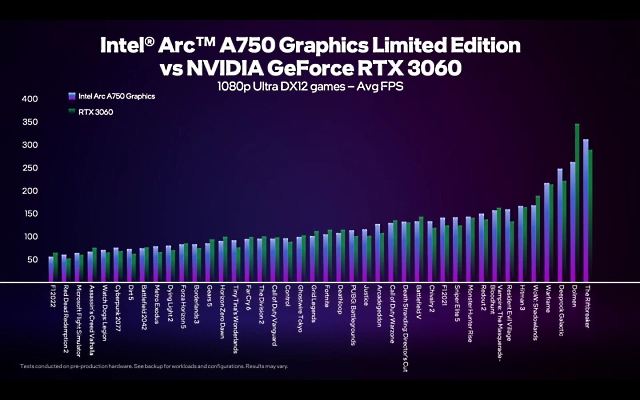
In another one of Intel’s performance showcases, we saw the Arc A750 Limited Edition compete with the Nvidia GeForce RTX 3060 across many different games like Dirt 5, Cyberpunk 2077, Hitman 3, and Fortnite. The fact that Intel chose the RTX 3060 for comparison is quite interesting and shows that Intel doesn’t want to compete for the performance title with its higher-end GPUs, but rather wants to invade the more popular mainstream graphics market.
Furthermore, this comparison also helps us guess the relative performance of the A770. How? Its bigger brother the A770 is very similar in its hardware makeup and technically is only separated by 4 Xe-cores. Therefore, with the performance of the A750 being on the same level as the RTX 3060, we believe that the performance of its big brother – the A750 (which has similar hardware components) should be around that of the RTX 3060 Ti.
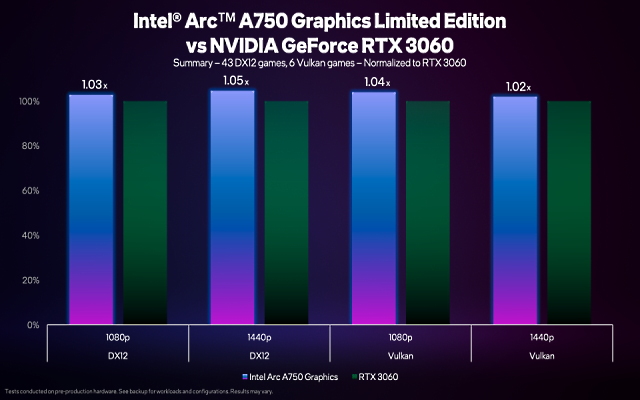
Intel Arc A380 vs Nvidia GTX 1650: Comparison
Now coming to the GPU that has actually been tested by many of the hardware publications, the Intel Arc A380. The GPU is mostly aimed at entry-level systems, but even if we compare it to those, the level of performance is not that impressive. Toms Hardware did an extensive breakdown of the A380’s performance, and it shows that while the A380 does come with the latest feature set, including AI upscaling and ray-tracing, its classic rasterization performance leaves a lot to be desired. It can only compete with the 4-year-old GTX 1650 in Nvidia’s lineup and the not-so-great AMD RX 6400.
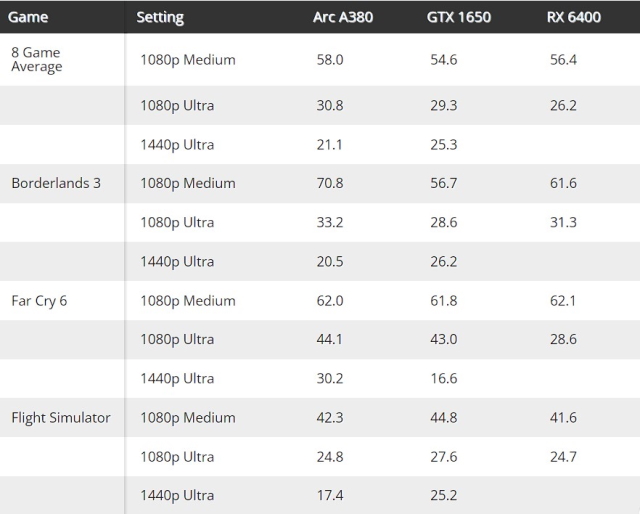
In a recent YouTube video, Hardware Unboxed also shared a detailed breakdown of a Gunnir-made Arc A380 with a top-of-the-line Ryzen CPU. In this review, the A380 was seen keeping pace with AMD’s RX 6400 GPU in most games. In some games like Tom Clancy’s Rainbow Six Siege, the Intel Arc 380 saw an average frame rate of 93 FPS compared to RX 6400’s 95 FPS. But, in some other games like Assassin’s Creed Valhalla, the Arc GPU struggled to even keep pace with Nvidia’s 1050 Ti, a GPU that was released almost half a decade ago.
This dichotomy in performance is fascinating, as the A380 is miles ahead of both the RX 6400 and GTX 1650 in raw transistor count (see specs comparison table below). Intel’s GPU also has more VRAM than the other cards and a better memory bus size when compared to the RX 6400.
So what could be the cause of the underwhelming performance of the Intel Arc A380? Now, it could just be that Intel has not done a good job in terms of the GPU architecture, but as many industry experts have argued, the problem lies not in the hardware but in the software department. More on the software side of things in the next section.
Specifications Intel Arc A380 Nvidia GTX 1650 AMD Radeon RX 6400 Process Technology 6nm 12nm 6nm Transistors 7.2 billion 4.7 billion 5.4 billion VRAM 6GB GDDR6 4GB GDRR6 4GB GDDR6 VRAM Memory Bus 96 bit 128 bit 64 bit Shading units 1024 896 768 Max Clock speed 2000 MHz 1665 MHz 2321 MHz TDP 75W 75W 53W
But all is not lost. During the testing of the Arc A380, Toms Hardware found that the ray tracing capability of Intel’s card, while relatively weak in comparison to an RTX 3050, was decent considering its 8 RTUs. The publication argued that it might be because of the advanced DX12 architecture or the higher 6GB VRAM. All in all, the A380’s ray tracing performance is revealed to be a match or even exceed AMD’s RX 6500 XT GPU. This means Intel’s high-end cards, which have many more ray tracing units, could end up being decent. So, Intel claims that the Arc A750 can more than match the RTX 3060 in DXR performance, while that A770 should be closer to the RTX 3060 Ti or even RTX 3070 seems plausible.
Another area where Intel Arc’s Alchemist architecture seems to succeed is video encoding, all thanks to the included AV1 video encoder. Initial impressions of the way AV1 encoder works have been good, and the fact that it can produce clearer images than other encoding formats (like Nvidia’s H.264) while using less data is something to be appreciated.
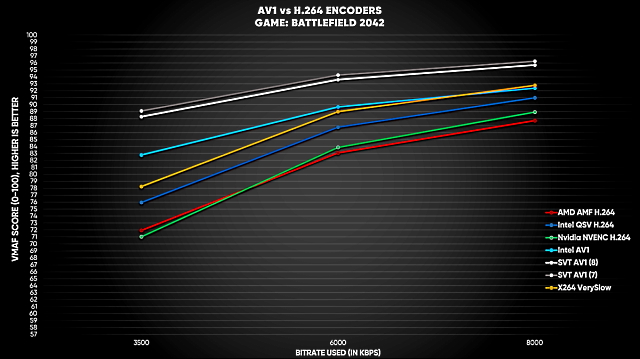
Most newer GPUs like, Nvidia’s RTX card and AMD’s RX 6000 cards, all have AV1 decoding abilities, which means individuals with these cards will be able to consume AV1-coded files, but the Arc lineup will be one of the first GPUs to feature a proper AV1 encoder (alongside Nvidia 4000-series), making it vastly more performant for video creators.
PCWorld has a good explainer on the AV1 encoding capabilities of the Intel GPU, including a deep dive into the idiosyncrasies of Intel’s approach to AV1. Though, to be clear, AV1 encoding will mainly only help you if you are into video editing or streaming. This means that there will be a negligible impact when it comes to gaming performance.
Intel Arc’s Three-Tier Strategy: GPU Optimization
Now you must be wondering — why is the performance of the new Intel Arc GPUs not up to the mark? It should be comparable to its Nvidia and AMD counterparts based on its specification, right? Yeah, theoretically it should. But there is a fundamental issue here. Let’s look at all the details.
For one, Intel’s architecture is heavily based on the DirectX 12 feature set, with emphasis on low-level APIs and specific hardware decoding like AV1. This makes it relatively good in games that support these features like Shadow of the Tomb Raider or Doom: Eternal, but it falters in older games that use older APIs like DirectX9 and DirectX11. As explained by Intel representatives in an interview with Linus Tech Tips on YouTube, these older games require dedicated tuning to make them compatible with newer hardware, and Intel argues, they just don’t have the time or resources to optimize hundreds and thousands of DX11/DX9 games right now.
This is the primary reason for the bad performance of Arc A380 in games that use older APIs like DX9 and DX11. To clear the air and make sure that Arc GPU buyers know what they are getting into, Intel has come up with something called the “Three tier strategy”. The idea is to split games into three different tiers of optimization that act as a sort of reference for the early adopters of Intel GPUs. Intel argues that by using this list, Arc users will be able to estimate what the performance level of different games will be. Here’s how that three-tier split will work:
Tier I: This tier includes games that support the latest APIs and have been optimized for Intel’s Arc graphics architecture. Intel, for now, has put newer games like Cyberpunk 2077 and Shadow of the Tomb Raider in this tier but has argued that the number of tier 1 games will increase in the future. The games in this tier use all the architectural benefits that Arc provides and are said to perform better than their immediate completion (A750 vs RTX 3060).
Tier II: Games in this tier have not been optimized for Intel’s Arc architecture as of now, but are based on newer APIs — DirectX 12 and Vulkan. This means they can take advantage of Intel’s architecture to some extent.
Tier III: This tier includes games based on older APIs like DirectX9 and will most probably run far worse on Intel’s GPU compared to the graphics cards from Nvidia or AMD in the same price range.
The fact that Intel has come out with such an honest take on their card’s current optimization needs to be respected. While, the solution is certainly flawed at the time being, there are definitely some positive aspects to this approach. For example, if you consistently play some of the latest titles, you will most probably get great performance comparable to AMD or NVIDIA cards. But if you are someone who likes to go back to nostalgic older titles, maybe some 7th-gen console titles, Intel Arc cards might not be the one for you.
Intel ARC Graphics: Release Date (Expected)
Now coming to the question that everyone is asking at the moment- when will the card be available to buy? This is the million-dollar question, and as much as we would like to tell you the exact release date of the GPUs, the information is just not there. The only set of clues we have come from the cryptic press releases or tweets that Intel posts from time to time.
For people who haven’t kept in touch with the Arc release, to put it simply, its launch timeline has been a rollercoaster. The Arc cards were initially supposed to launch at the start of 2022, but after the release of the A380 was delayed to the summer, but even that release (at least not globally) never saw the light of day.
The latest news we have comes from Intel, which says we will get further updates “next quarter“. Now, what does this mean? If we are to take Intel quite literally, the start of the next quarter, which is Q4, would be October. This seems to be in line with the new information that has been made available online about the embargo guidelines of the new Intel Arc A770 graphics card.
According to a report by Videocardz, we will get hands-on unboxing videos of the Intel Arc A770 on Friday, September 30. This will then be followed by a go-ahead for reviewers to publish their full reviews from Wednesday, October 5. However, like all rumors, this information is not 100% confirmed and we should take it with a pinch of salt as Intel hasn’t come out with a dedicated statement yet.
So all hope is not lost. Furthermore, many experts argue that the recent burst of Intel blog posts and media appearances could indicate that the official release of the cards could be close. But the fact that there is no release date, despite the GPUs being at such an advanced stage is concerning. What is causing this delay? Are they waiting for software optimizations, or is it something more fundamental?
Launch Confusion: Is Intel Arc Cancelled?
Well, it’s all this confusion that has made PC enthusiasts question whether the Intel Arc graphics cards are being canceled or not. While something like this might sound outrageous to a layman, many tech insiders argue that, unlike previous rumors that have seen the light of day, this one seems to have some backing of facts.
So what is the cause of this discussion? The rumor that Intel is ready to abandon its Arc platform comes after many industry experts have claimed that Intel’s Graphics division is currently causing the company to hemorrhage billions as it struggles to launch Arc graphics cards in the market. The source they cite is the quarterly financial report that Intel submitted at the start of August, where Intel stated that their overall revenue is down 22%.
But are these claims true? Yes, to an extent. We have seen firsthand the disastrous way in which Intel has handled this launch so far. After resorting to only a small regional launch (China) in the February launch window, and then missing the summer release window, the past few months have seen Intel continually struggle to kick a single graphics card out the door. Furthermore, leaks from graphics card makers and PC system builders appear to tell a story that Arc cards are already made and waiting in warehouses, but it’s the software and drivers that aren’t up to scratch. The delay has gotten so bad that Intel’s own promotional Arc GPU giveaway in March 2022 had to give winners CPUs rather than the Arc graphics cards they had won.
It was following this news of Intel’s GPU division shedding billions, longtime graphics analyst and market researcher Jon Peddie called it an embarrassment and suggested Intel should sell or fold the division entirely. Peddie cited that Intel CEO Pat Gelsinger wasn’t afraid of making tough decisions after he recently sold and killed off several divisions, including Intel Optane.
So is this the end of Intel Arc? Not really. While Intel’s urgency in closing out non-profitable ventures is quick, we don’t think the latest Arc platform will meet the same fate. Gaming has been a major propellant for the PC market for over a decade, with GPUs taking an ever larger slice of the pie with every new generation. The graphics market has become too big for Intel to opt out now, so they simply have to work it out. This sentiment was sort of echoed by the head of Intel AXG, VP Raja Koduri, when he tweeted in response to some rumors and said, “We are very much committed to our roadmap,’ and promised ‘four new product lines by the end of the year.’
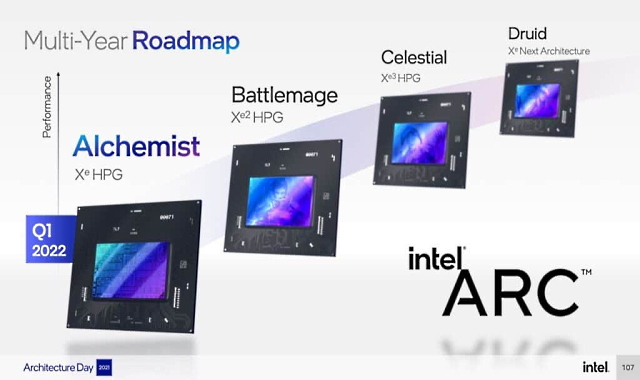
This corresponds to what Intel had declared in their official release last year at Intel Architecture Day 2021. At the conference, they not only told us that the official codename of the first Xe-HPG was Alchemist, but also gave a clear roadmap/ naming scheme for three other future GPU generations, namely Battlemage (Xe2 HPG), Celestial (Xe3 HPG), and Druid (Xe4 HPG).
These all fall under Intel Arc, the new architecture, and are set to release in the coming years. So looking at both the claims and statements from Intel, we could argue that internally they have committed to sticking with Intel Arc GPUs up until 2025 or later. Now, will they stick to this plan? Guess we will find out.
Intel ARC Graphics Cards: Pricing (Rumored)
Finally, coming to one of the most important aspects, i.e. the pricing of Intel Arc graphics cards. This, again, has been an elusive aspect of the Intel Arc GPUs. Intel CEO Pat Gelsinger has spoken numerous times about the topic of Arc pricing but has never really divulged any concrete info. Most of the time, his speeches have revolved around the question of market monopoly, about how Nvidia’s immense success could be attributed to the lack of competition. However, Gelsinger does emphasize the fact that Intel has to be very competitive in terms of pricing to dethrone AMD and Nvidia.
But for now, the exact prices of Arc Alchemist GPUs are a mystery. The only thing we know for sure is the Intel Arc A380’s pricing in China, which launched with a price tag of CNY 1,030. And if we convert that to American dollars comes to about $153, not accounting for regional price differences.

We have seen some good-quality leaks, though, like the aforementioned Wccftech report, which suggests that Intel has a price structure in mind. Again, these might be unreliable and are subject to change, but the leaked image does seem legitimate and is on the same tangent as Intel’s claims. So using the leaked image as a clue this is what we can expect – the Arc A770 will most probably be in the $350-$399 price range, with the A750 just below at about $290-$340. At this price point, the cards will trade blows against cards like RX 6600 and Nvidia RTX 3060, which is what Intel compared the performance of their cards to in their August reveal.
Next up will be A560, which will come out at around $200-$250 and will be part of Intel’s performance lineup. Moreover, according to the report, this GPU will be the bread and butter of their 1080p gaming lineup. In terms of price and performance, this GPU will compete with the RTX 3050, the dominant mid-range GPU from Nvidia. Moving on to the lower end of the spectrum, we get the Intel Arc A380 down at $150 and the A310 at $99 or below. These cards are most like entry-level cards, and as we have already seen in the case of the A380 can compare with the likes of the GTX 1650 in terms of performance.
So, the final pricing of the GPUs, at least relying on the leaked estimates for the prices of the Intel Arc GPUs, could look something like this:
- Intel Arc A770 – $400
- Intel Arc A750 – $300
- Intel Arc A580 – $250
- Intel Arc A380 – $149
How does this stack up with the competition? We would argue that it’s competitive, as Intel intended. Looking at A380’s performance, it is a competitive card in its price bracket at $150, but the question remains whether consumers will see it that way, especially with Nvidia and AMD offerings in the market. Going with a first-gen Intel discrete GPU has a variety of compromises at the moment like the lack of support and bad optimization for older titles. But for what it’s worth, if Intel can stick to the rumored prices and work on their game optimizations, the GPU market could turn spicy.
Intel’s ARC GPUs: Everything You Need to Know
The bottom line is that Intel is going to have a rough ride if the Arc release continues in the same manner as it has been going. It may be a titan when it comes to the CPU world, but in the GPU space, it’s a newcomer, and till now, has had a shaky start. As the graphics underdog, if Intel wants to make a mark in this market, the company needs to come out with not just aggressive pricing but also strong performance and a rapid pace of improvement. But looking at the performance metrics from both Intel’s own performance numbers and other hardware reviewers, the level of performance required from a current-gen GPU is just not there. Some people argue that if Intel Arc GPUs release in good condition (in terms of driver performance), then Intel could find some footing in the market. However, as we move further into 2022, the situation doesn’t look as rosy. GPU prices for both AMD and Nvidia cards are finally returning to normal, and in the case of higher-end cards, well below launch prices. This makes the graphics card market particularly hostile to any newcomer, let alone someone like Intel that suffers from severe performance and driver issues.
Can Intel capture some of the market shares away from AMD and NVIDIA? We definitely hope so. The fact that we are on the precipice of having a third player in the GPU after years of inflated graphics prices and zero competition is a blessing. Though delayed, Intel’s foray into the graphics card world signals to the industry leaders, AMD and Nvidia, that they can’t be complacent anymore, that they can’t regurgitate older GPUs and call them new ones. And if they do, a similar fate will meet them, a fate that Intel has definitely had an experience of. So till then, let’s hope Intel can release the Arc A750 and A770 cards in a timely fashion and that Intel doesn’t send Arc the way of the dodo. Now, what do you think of Intel’s new Arc graphics cards? Do let us know in the comments below.


















